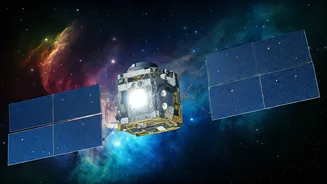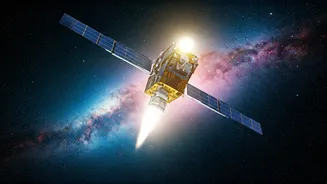Lightspeed Pathfinder Debut
Telesat has marked December 2026 as the target date for the Lightspeed pathfinder debut. This initiative is a vital component of Telesat's overall strategy
to establish a sophisticated Low Earth Orbit (LEO) satellite network. The pathfinder will function as a testbed for innovative technologies and operational procedures before the full Lightspeed constellation is deployed. This initial step will allow Telesat to assess the performance of its advanced satellite systems in space, thus optimizing the development and deployment phases of the broader network. The mission also involves detailed analyses of satellite-to-satellite and satellite-to-ground communications. This analysis will guide enhancements in signal management, data transmission rates, and overall network efficiency. Success of this debut will set the stage for further enhancements.
Space Exploration Discussion Series
Alongside the pathfinder announcement, collaborations have emerged within the space industry. Johns Hopkins, alongside SpaceNews, have initiated a discussion series centered on the future of space exploration. This collaboration serves as a platform for experts and stakeholders to engage in critical dialogue regarding emerging trends, challenges, and opportunities in the space domain. Through a series of panels, webinars, and articles, the initiative aims to facilitate informed discussions on technological advancements, policy frameworks, and investment strategies. They also plan to help the industry navigate the ever-evolving landscape of space exploration. The goal is to drive innovation and promote strategic partnerships.
Geopolitical Impact
The geopolitical landscape, along with advances in Artificial Intelligence (AI), is causing major shifts in the Earth observation market. As nations and organizations navigate their security, economic, and environmental concerns, the demand for sophisticated Earth observation capabilities continues to rise. The incorporation of AI is leading to advancements in data processing, analysis, and interpretation, enabling faster and more accurate insights. Such tools allow for more real-time monitoring of global events, from climate change and resource management to security and disaster response. These geopolitical shifts will likely shape the commercial direction of the space sector. This includes increased investment in advanced satellite technologies, along with more collaborative efforts across various international players.
Osiris Computer Module
PDC has revealed the Osiris Computer Module, a significant development for next-generation space missions. The module features Microchip's PIC64-HPSC, a high-performance, space-qualified microcontroller. This announcement underlines the continuous innovation taking place to improve the capabilities of space-based systems. Osiris is designed to meet the increasing need for advanced processing capabilities in satellites and spacecraft. This allows missions to handle complex tasks, such as high-resolution imaging, data processing, and advanced communication protocols. The adoption of the PIC64-HPSC microcontroller provides a robust and reliable platform for mission-critical operations. The Osiris Computer Module is positioned to play an important role in enabling future advancements in space exploration, by supporting the needs of a diverse range of space missions.












